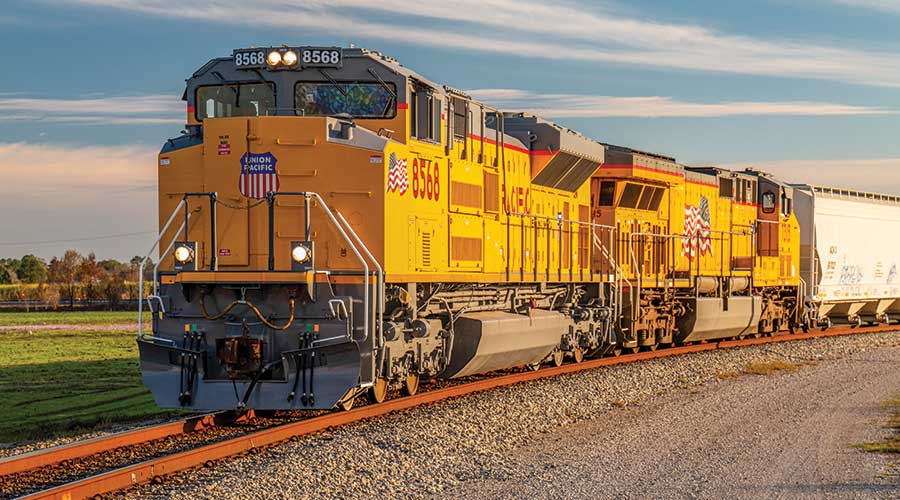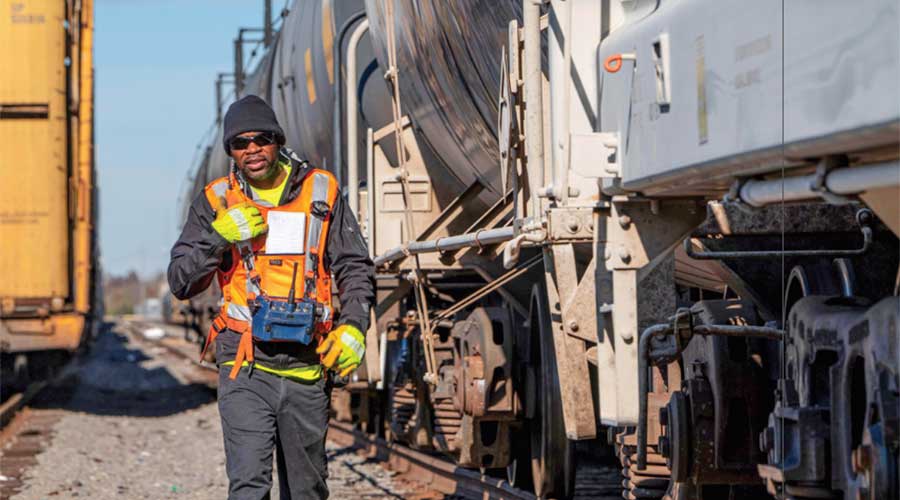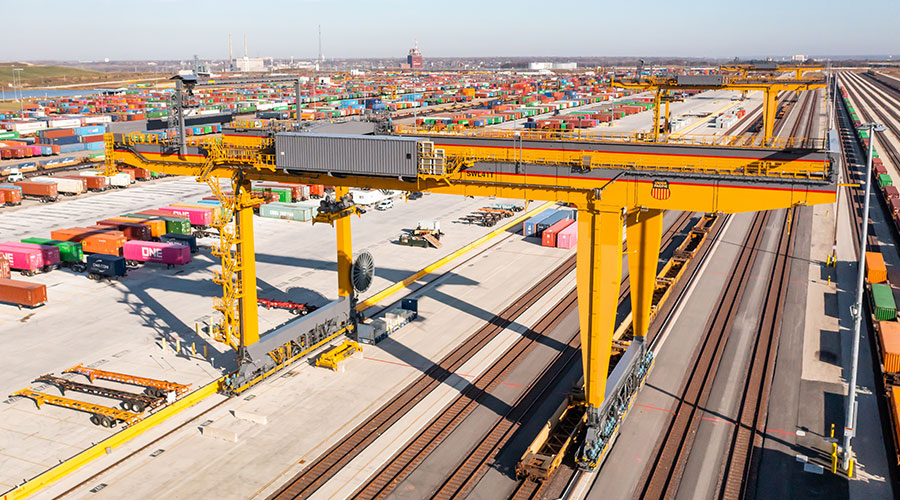Stay updated on news, articles and information for the rail industry
October 2011
Rail News: Rail Industry
At Union Pacific, the floods of 2011 proved to be a watershed event of sorts
by Jeff Stagl, managing editor
From his 19th floor office at Union Pacific Railroad's headquarters, Jim Young has a picturesque view of the Missouri River undulating through downtown Omaha, Neb. But on Aug. 23, the view wasn't all that breathtaking for the Class I's chairman, president and chief executive officer. Water flooded well over the river's banks, enveloping many buildings, streets and parking lots near the waterway.
For months, Young had monitored the river each day to gauge if rising waters could be raising havoc with UP's network.
"It doesn't take me long to know what we're facing," he said, pointing at the swollen waterway.
What Young and his senior team had faced since May were massive floods along the river, triggered by record snowfalls in the Rocky Mountain regions of Montana and Wyoming, and near-record spring rainfalls in central and eastern Montana. The floods — which spread 10 miles wide in some spots — caused extensive damage to UP's infrastructure in North and South Dakota, Iowa, Kansas, Nebraska, Missouri and Montana, primarily to track, bridges and signals. Floodwaters prompted many traffic detours, as well.
The cost by the time waters completely recede sometime this month: more than $50 million in capital and operating expenses combined, including lost revenue and infrastructure repairs, Young estimates. In the second quarter alone, UP lost about 14,000 carloads of coal and $20 million in coal revenue because mainlines vital to Powder River Basin traffic were submerged.
Although the floods are considered historic, they aren't the worst ones UP ever encountered, says Young. Major flooding along the Missouri and Mississippi rivers in 1993 washed away track and closed major pieces of the railroad, while the recent floodwaters rose more slowly, pouring over track instead of washing it out, and impacted mostly key energy sector lines, he says.
Yet, the great floods of 2011 have been a watershed event of sorts for UP. Recovery practices that have been refined and developed the past few decades after numerous natural disasters were put to the sternest test since the '93 floods, and predominantly passed muster, senior executives say. Among them: a "surge resources" plan put in place several years ago. The plan is designed to ensure critical resources — such as manpower and locomotives — are readily available if an unexpected event or traffic spike occurs.
In addition, key infrastructure that was bolstered the past several years through increased capital investments provided the route flexibility network planners had hoped would be available in an emergency, says Young.
Learning Curve
The management team also learned a few things during the course of the event they hope will pay dividends when the next crisis occurs.
"We could have staged resources a little more diligently," says Young. "You can only plan for bad weather to a point."
Moreover, the natural disaster enabled sales and marketing executives to analyze and improve the ways customer service representatives communicated with shippers about anticipated traffic problems and recommended solutions. And engineering department managers could gauge their performance in dealing with strained resources and taxed maintenance-of-way workers.
UP workers were up to the challenge, says Young. Outside of two lines that were completely shut down for about a month, most damaged infrastructure was quickly repaired, impacted track and bridges were raised above flood levels, and traffic was restored to normal in a manageable amount of time. In part, Young credits a determined workforce.
"We always have bad weather to deal with. A board member once said, ‘Doesn't it snow every year?' But we have to produce," he says. "How do you handle a challenge like this, and how do you perform? We have people who work hard, and put in long hours and understand their role. We all know it's the nature of the business."
UP lost traffic to other modes because of flood-related delays, but by year's end, most of it should be recovered, Young believes.
"You never want to miss a load," he says. "We'll lose pockets of business, but … they will come back."
At It From All Angles
Ultimately, the floods and a few other unexpected events enabled the senior team to prove their mettle as multi-taskers. Chemical business in the South was stronger than anticipated through the year's first half, requiring senior execs to employ additional resources in the region — namely, 300 more train crew members — on top of those assigned to flood recovery efforts, such as 100 locomotives taken out of storage, and hundreds of formerly part-time and furloughed workers who became full-time help.
While guiding flood recovery work, the senior team also dealt with another blow from Mother Nature. More than 100 days of temperatures exceeding 100 F and a prolonged drought through summer in parts of Texas caused track to kink or sink into compromised subgrades. Located mostly on single-track lines, the rail and subgrades would be repaired, then kink or sink again — a pattern that sometimes repeated three or four times.
A detailed contingency plan was paramount to ensuring enough resources could be assigned to all problem areas, says Young. Advance preparation for unexpected events is vital because there's sure to be more severe weather in the years ahead, be it floods, mudslides or hurricanes, he says.
"The most important things we can do are develop a strategy to address each situation, provide the necessary resources to implement that strategy and communicate with all affected parties," says Young. "On July 1 of 2012, we will be 150 years old, so we have had a lot of practice in dealing with weather issues."
Practice Makes Perfect
Workers in the engineering, transportation and a host of other departments got more practice than they bargained for during the recent Missouri River floods. At the onset of the flooding, a cross-functional operating team — which included signal, bridge, welding, surfacing and track gangs, as well as dispatching, network planning and transportation workers — was assembled to coordinate the flood management plan, says Executive Vice President of Operations Lance Fritz.
UP managers also worked closely with U.S. Army Corps of Engineers representatives and local officials to stay abreast of planning efforts that could impact train operations and customers' facilities, he says.
In addition, the railroad hired hydrological experts to help address flood management issues, such as the magnitude and duration of floods. UP managers worked with the experts to create inundation maps.
"This told us where we needed to do the work," says Fritz.
UP outsourced some site preparation and excavation work, but performed most flood repair work in house, primarily by reassigning MOW workers from construction projects to flood avoidance projects. UP also recalled more than 300 train, engine and yard employees who had been furloughed.
As of late August, crews raised about 74 miles of mainline track from several feet to six feet high; raised three miles of sidings; raised and cleared nine bridges; laid more than 458,000 tons of aggregate (ballast, rip-rap and other materials) — enough to fill more than 4,800 rail cars; and removed and replaced hundreds of track signal components.
In one location, the engineering team needed to raise track and a bridge about 29 inches, but floodwaters already had climbed to the bottom of the bridge deck. So, crews removed the rail, placed timber stringers on the old deck and built a new deck on top of the old one.
"Basically, we have a double-decked bridge," says Fritz. "We found we could build a new track structure on an existing bridge."
Crews also determined that a Loram Maintenance of Way Inc. track lifting machine could help speed up track-raising projects, he says.
"We could lift track three times faster," says Fritz.
When lifting track at crossings, crews constructed a berm and cut a section in the highway to redirect water flow.
Keeping Options Open
A majority of flood-related repair was performed on a River Subdivision line between Kansas City and Jefferson City, Mo., and a Falls City Subdivision line between Atchison and Leavenworth, Kan., which were under water and closed for about a month. As floodwaters recede along the lines, workers will continue to reestablish walkways where track was raised more than one foot; inspect all bridges for substructure damage and scouring; inspect all culverts; re-install and power up signal components; and further surface track, says Fritz.
Despite all the ongoing, 24/7 work — which involved six dozen pieces of equipment and sometimes required employees to perform tasks "outside their norm" — the railroad didn't register any incidents or injuries, he says.
"We rely on a solid safety foundation. We all have muscle memory, and we need to make sure that holds," says Fritz. "This didn't show up as a blip on our safety statistics."
However, flood recovery work did show up as more than a blip on traffic logs. Trains needed to be rerouted around many flood-impacted areas.
So, UP managers on June 4 created a "flood desk" manned by six to 12 employees who helped manage flood response efforts to keep lines open. The 24/7 flood desk was a "natural progression" from a command center concept the railroad used for many years in conjunction with large projects, says Fritz.
Desk personnel helped redirect traffic, primarily to Chicago or Denver.
"Our people took it as a personal front to have to reroute traffic," says Fritz.
The Harriman Dispatch Center in Omaha was at the forefront of most detours.
Dispatchers helped accommodate all rerouted trains with the appropriate resources, such as crews, locomotives and track space, says Vice President of Dispatching and Network Operations Steve Barkley.
Some dispatchers' jobs were split because of the extensive trackwork, loss of Centralized Traffic Control and need to use a manual track warrant system, he says. In addition, extra workstations were employed — including workers that typically cover other dispatchers when they're sick or on vacation — to handle all dispatching needs. Dispatchers worked with their counterparts at Canadian Pacific, Norfolk Southern Railway, Kansas City Southern and Iowa Interstate Railroad Ltd. to reroute trains on other railroads' lines at the height of track outages in the Falls City and River subdivisions.
Total cycle times on some trains heading to St. Louis and terminals on the Ohio and Mississippi rivers were about a day longer than usual, says Barkley.
"The challenge was supplying the resources to move volumes on alternate routes, including locomotive demand," he says. "The incredible determination and persistence of our engineering team helped keep routes open or re-opened lines that were flooded."
Milling About
A manager at a large Cargill Corn Milling North America biorefinery in Blair, Neb., that was heavily flooded appreciated UP workers' efforts to repair track and keep ingredients flowing into the facility. The company's own workers built a berm more than three miles long and seven or more feet high to abate the floodwaters at the more than 600-acre facility, which produces ethanol and fructose, says Jim Johnson, Cargill Corn Milling's western region commercial operations manager.
During the first few weeks of heavy flooding, Cargill Corn Milling and UP officials conducted daily telephone calls to discuss how many rail cars would be needed the following day.
"Communication was at a good level. We knew early on that it would be an all-summer-long activity, so communication was critical at the front end," says Johnson.
For about a month, the plant dealt with "abnormal" service, such as receiving no trains on some days, he says.
On lines serving the biorefinery, UP crews raised 19 miles of track about 18 inches in the Omaha Subdivision and 11 miles of track from several inches to six feet in the Blair Subdivision to maintain service.
"We worked together to have cars available to get products into the plant," says Johnson.
Sales and marketing representatives tried to work with customers who had "jeopardized shipments" and keep them informed as much as possible during the floods, says EVP of Marketing and Sales Jack Koraleski. For example, department employees set up transloads for some shippers.
"It comes down to how well you provide clear and concise communication with customers. As soon we saw it coming, we let them know," says Koraleski. "The big thing for customers is that when there's a fall off, have a system in place to fix it."
Despite the floods' impacts on service, customers rated UP a 90 out of 100 in a July satisfaction survey.
"Three years ago, if you would have told me we'd get a 90 in a monthly survey, I would have just about gotten down and died," Koraleski joked. "Customers are asking us to raise the bar, and that's OK."
What was more than OK was the department's ability to generate new business during the crises. In August, the railroad obtained a contract from an auto manufacturer to move vehicles produced on the East Coast into Texas. The moves — which were slated to begin in fall — will generate about $9.5 million annually, Koraleski estimates.
"You get so mired down in a crisis situation, it's hard to think about new business," he says.
It's also difficult for senior execs to focus their attention on growing traffic in the face of a natural disaster. But Koraleski believes volume will increase through the remainder of the second half.
Energy traffic — which was impacted the most by floods — will benefit from new Wisconsin utility business and a new coal-fired facility coming on line near Waco, Texas; intermodal traffic will be driven by a decent but somewhat compressed peak season; ethanol traffic will be boosted by a soon-to-launch plant-to-port service that calls for moving bulk dried distillers' grains for transload into export containers; chemical traffic will be propelled by ongoing shale development and seasonal fertilizer demand; and auto traffic will be strengthened by Japanese manufacturers' continued recovery, says Koraleski.
Positive Reinforcement
UP will meet its growth goals if all departments continue to exude the teamwork that was evident during the crisis, he says.
"These events reinforce the value of our great internal working relationships, especially those between marketing and sales, and engineering and operations," says Koraleski. "You also can't look back at any of these types of natural disasters without clearly understanding the value of proactive communication with your customers. The absence of solid working knowledge can lead to poor decision-making."
The decisions the senior team makes now will impact future volume and revenue growth, and they need to be made whether there's a crisis at hand or not, says Young. For example, the team in May decided to increase 2011 capital spending by $100 million to $3.3 billion.
"It's easy to hunker down and not talk about or consider the future," says Young. "But now is the time to build for the future."


 2025 MOW Spending Report: Passenger-rail programs
2025 MOW Spending Report: Passenger-rail programs
 Gardner steps down as Amtrak CEO
Gardner steps down as Amtrak CEO
 Guest comment: Oliver Wyman’s David Hunt
Guest comment: Oliver Wyman’s David Hunt
 Women of Influence in Rail eBook
Women of Influence in Rail eBook
 railPrime
railPrime







